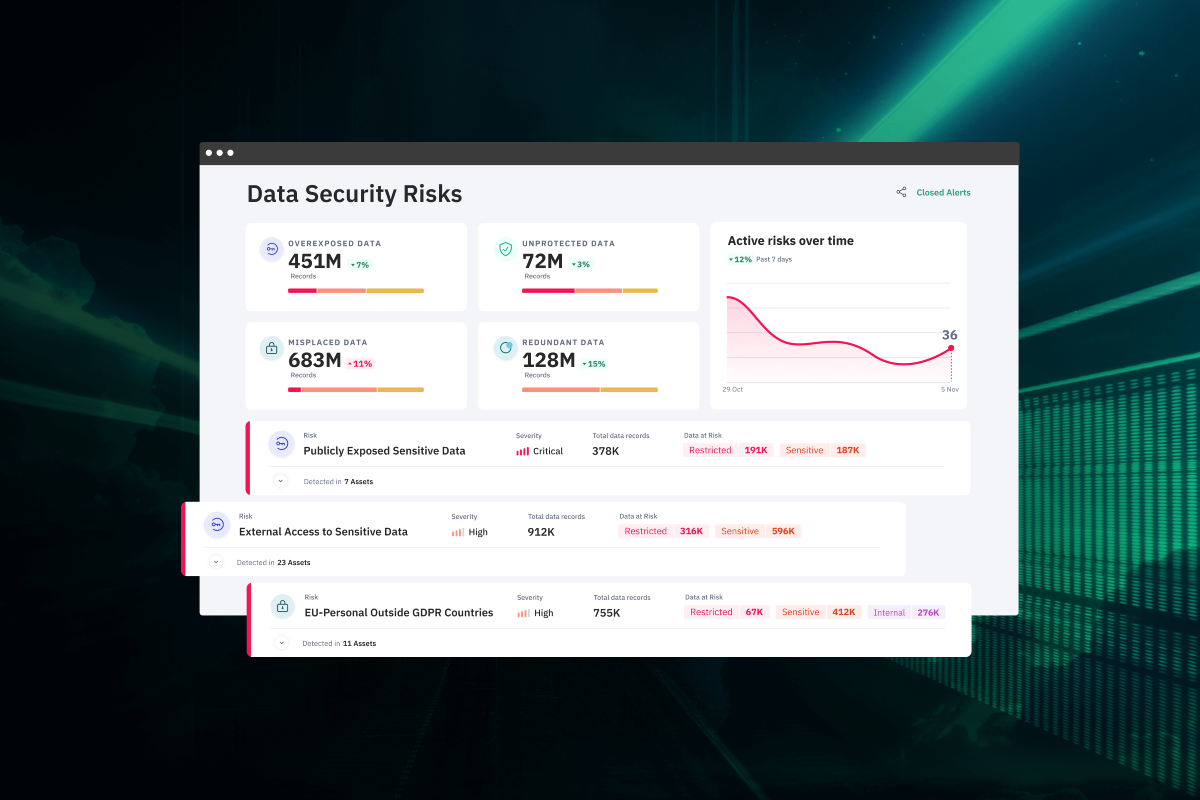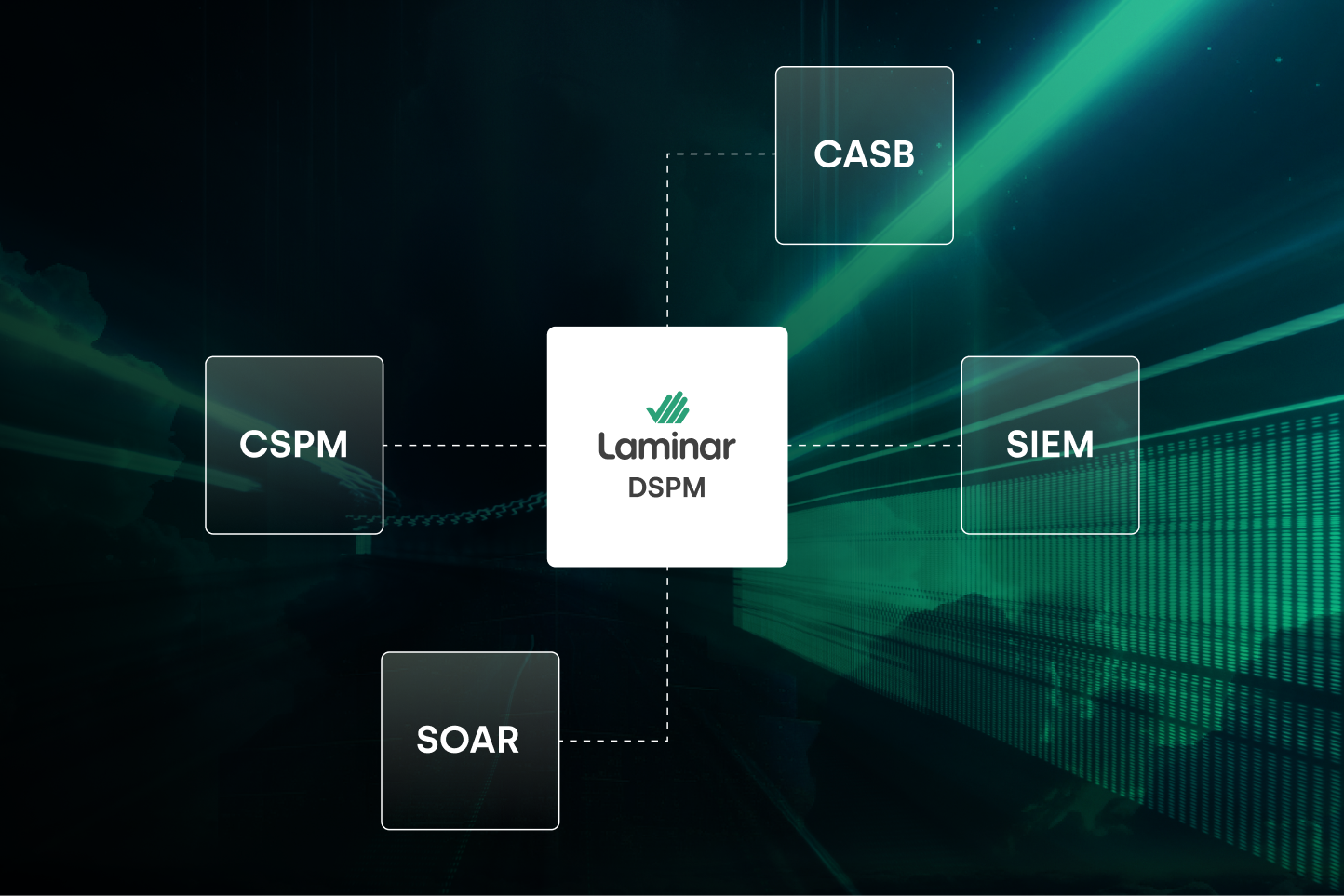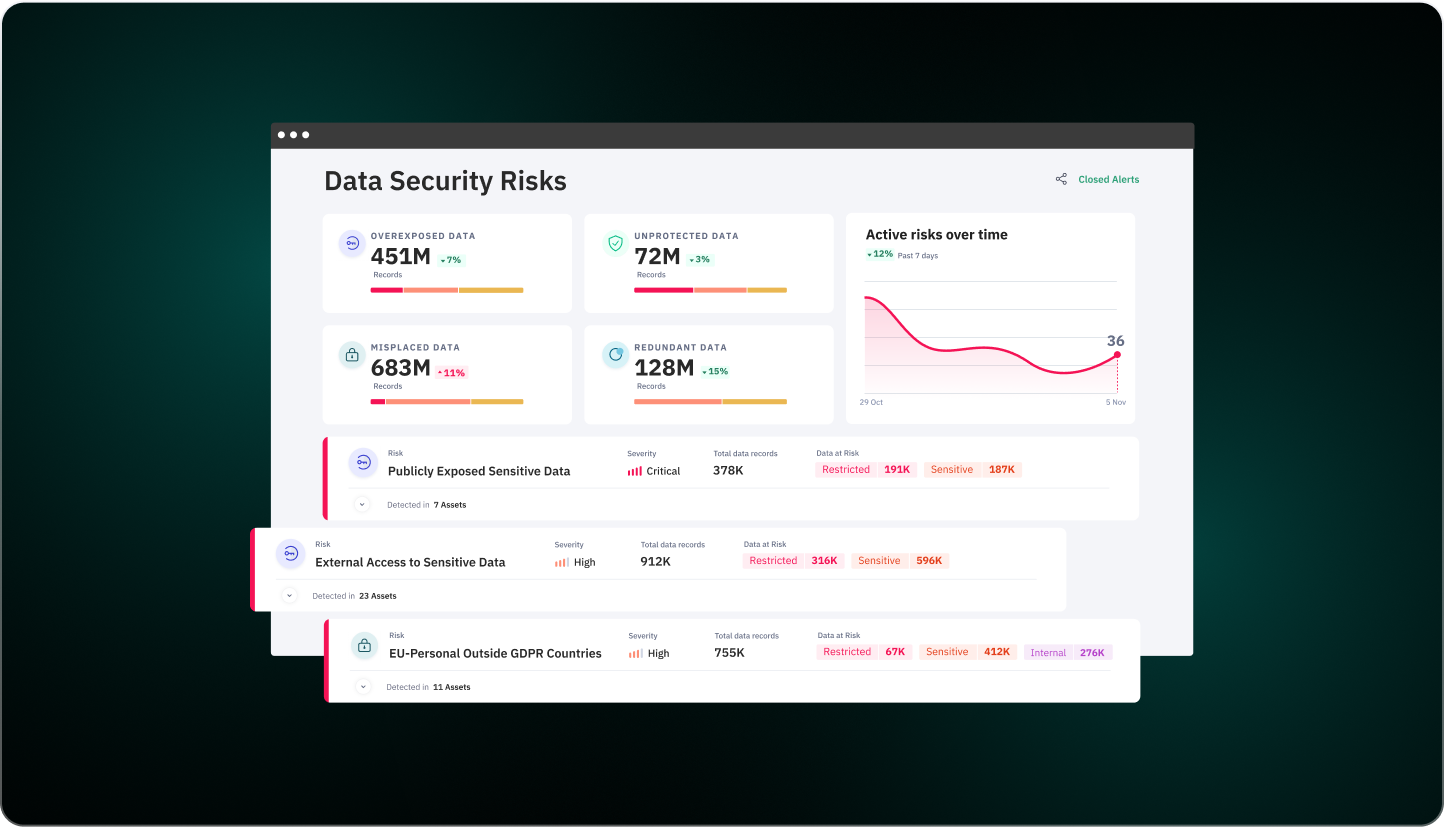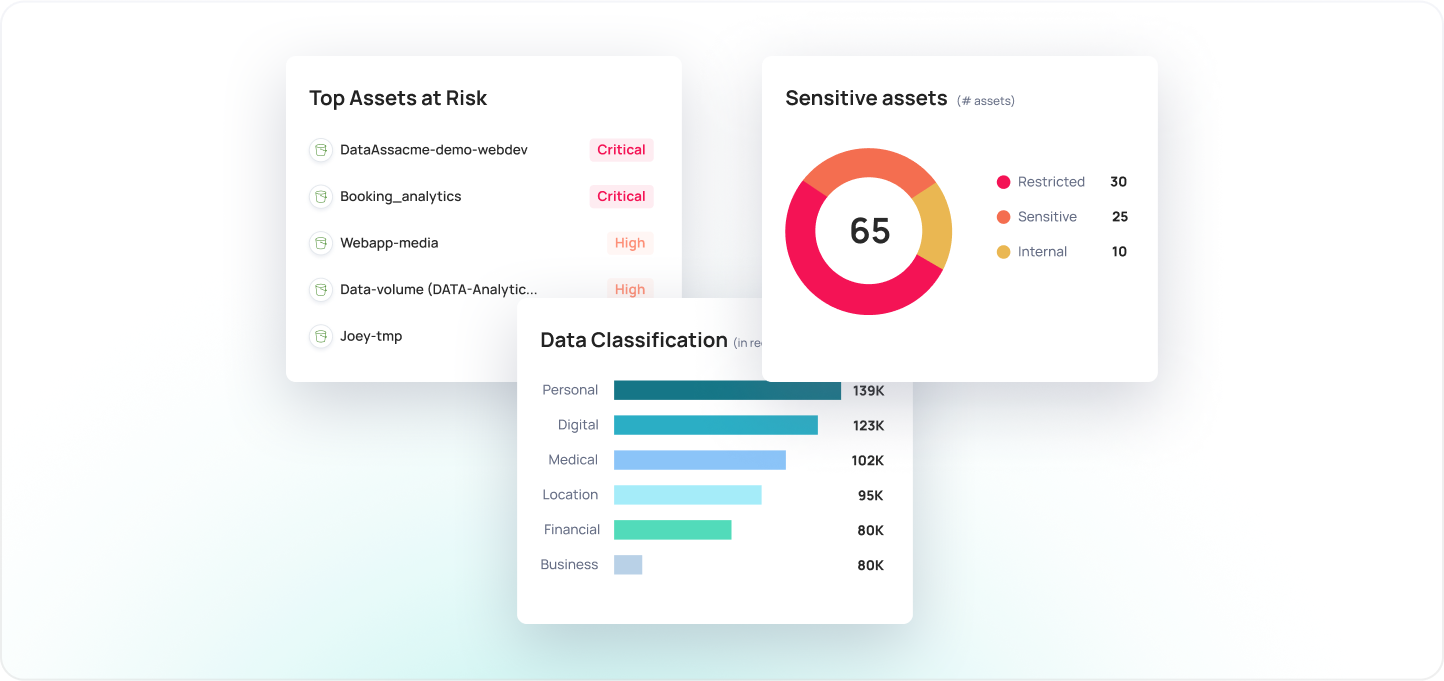A guide on how to leverage DSPM with your security stack and enhance data security posture
November 17, 2023 | 12 min. read

The proliferation of cloud-based computing has allowed organizations to innovate at an unprecedented pace. It’s also created a sharp rise in cloud data, and along with that, the challenge of protecting this data from malicious elements that live online, such as data breaches, misuse, violation, and leakage to a business.
Increasingly, businesses are turning to what Gartner™ has termed Data Security Posture Management (DSPM). This is a term that describes software solutions that have been developed to classify and protect data natively inside a range of existing cloud environments.
DSPM solutions help organizations achieve data security compliance, reduce data breach risks, lower cloud costs, remediate ROT data, and enable data-driven innovation. If you’re interested in learning more about how to choose a DSPM Solution for your organization, we’ve put together a comprehensive guide to help you make an informed decision.
Organizations need other cloud security tools that complement DSPM and help them secure all aspects of their cloud environment, such as infrastructure, applications, services, identity, access, encryption, vulnerability management, etc. Some examples of other cloud security tools are Cloud Security Posture Management (CSPM), Cloud Access Security Broker (CASB), Security Information and Event Management (SIEM), Security Orchestration Automation and Response (SOAR), and more.
In this article, we will help you understand DSPM integrations with other cloud security tools to enhance your cloud security posture. We will also show how Laminar can help you achieve seamless and effective integration with various cloud security tools.

While innovative DSPM provides data security, and it works best when paired with CSPM, allowing for a more robust security coverage.
CSPM, cloud security posture management, helps secure your cloud infrastructure configurations and policies. CSPM solutions scan and monitor your cloud resources and identify any misconfigurations or vulnerabilities that could expose your data or compromise your security. CSPM solutions also help you remediate or prevent any misconfigurations by applying best practices and standards.
DSPM adds a layer of data awareness and protection to CSPM. While CSPM helps you secure your cloud infrastructure, Laminar’s DSPM secures your cloud data. DSPM solutions scan and monitor your cloud data and identify any sensitive or regulated data that could be at risk or non-compliant, and they do so no matter where the data resides. Because of this, DSPM complements CSPM solutions. DSPM solutions provide additional data context, such as sensitivity and usage details, so you can better prioritize remediation efforts. DSPM solutions also help you remediate or improve data security posture by orchestrating appropriate actions such as encryption, masking, tokenization, deletion, quarantine, etc.
By integrating DSPM with CSPM, Laminar allows you to achieve a comprehensive and strong cybersecurity posture. It ensures that both your cloud infrastructure and your cloud data are secure and compliant. This also reduces the likelihood and impact of data breaches and data leakage in your cloud environment. To learn more about the differences between DSPM and CSPM, check out our blog post on DSPM vs CSPM, and why you need both for comprehensive cloud security.
Some use cases and scenarios of how DSPM and CSPM work together are:
Laminar provides you with easy and seamless integration with various CSPM solutions such as Wiz and Orca. Laminar also provides you with a unified dashboard that shows you both your data security posture and the related assets on which your data resides, both known and unknown instances, along with public exposure configuration status.

CASB is a cloud security tool that helps you secure your cloud applications and services, focused primarily on SaaS apps. CASB solutions act as a gateway or a broker between your users and your cloud applications and services. CASB solutions monitor and control the access and usage of your cloud applications and services, and enforce security policies and rules.
DSPM provides data security capabilities, unlike CASB. While CASB helps you secure your SaaS applications and services, DSPM helps you secure your cloud data. DSPM solutions scan and monitor your cloud data and identify any sensitive or regulated data that could be at risk or non-compliant. It does this without regard to the data location – therefore it finds data in unknown or shadow stores. Because CASB requires pre-configuration, it only secures known applications (and hence the data within). DSPM solutions also help you remediate or prevent data security risks by orchestrating appropriate actions such as encryption, masking, tokenization, deletion, quarantine, etc.
By running both DSPM and CASB, Laminar helps you achieve comprehensive and holistic cloud security posture management. You can ensure that both your cloud applications and services and your cloud data are secure and compliant. You can also monitor and control the access and usage of your data in your cloud environment.
Some use cases and scenarios of how DSPM and CASB work together are:
Laminar provides you with easy and seamless integration with various CASB solutions such as McAfee MVISION Cloud, Bitglass, Netskope, and others.
Security Information and Event Management (SIEM), as the name implies, is an incident and event management tool that helps you collect and analyze security data from various sources. SIEM solutions aggregate and correlate security data from different sources such as logs, events, and alerts, and provide you with insights and intelligence on your security status and performance.
DSPM enriches the data security intelligence of SIEM. While SIEM helps you collect and analyze security data from various sources, DSPM’s byproduct (metadata) helps you to further analyze security info from your cloud data. This enriched context can inform analysis of the ‘importance’ of an event based on the sensitivity of the data at risk – allowing better prioritization of remediation steps.
By integrating DSPM with SIEM, you can achieve a comprehensive and holistic cloud security posture management system and simultaneously streamline policy optimization and incident response workflows. Some use cases and scenarios of how DSPM and SIEM work together are:
Laminar provides you with easy and seamless integration with various SIEM solutions such as Splunk, Coralogix, Datadog, AWS Security Lake, and more. Laminar leverages the APIs of the SIEM platform or service for integration. Laminar also provides you with a unified dashboard that shows you both your data security posture and your security data intelligence (i.e. context) in one place.
Security Orchestration, Automation, and Response (SOAR) is a cloud security tool that helps to automate and orchestrate security workflows and actions. SOAR solutions enable you to define and execute security playbooks that automate and coordinate various security tasks and responses across different tools and teams.
DSPM empowers the data security automation and orchestration of SOAR. By integrating DSPM with SOAR, you can better achieve agile data security posture management for your organization. You can ensure that both your security workflows and actions and your data security workflows and actions are automated and orchestrated, delivering a more responsive and scalable security architecture. This allows you to continuously safeguard data as your cloud usage expands, without drastic resource additions or cost increases.
Some use cases and scenarios of how DSPM and SOAR work together are:
Laminar provides you with easy and seamless integration with various SOAR solutions such as Palo Alto Cortex XSOAR, Rapid7 InsightConnect, IBM Resilient, and more. Laminar leverages the native capabilities of the cloud platform or service for integration.
DSPM must also integrate with Identity Management and IdPs, such as Okta, Key/Secrets Management, such as AWS KMS, and Vulnerability Management, such as Qualys, Tenable, etc. These tools offer various cloud security aspects like identity and access management, encryption and key management, and vulnerability management. DSPM supplements these solutions by providing data awareness and protection, leveraging APIs or SDKs for seamless integration.
Okta manages and secures users and devices in your cloud environment, while DSPM’s integration allows data discovery, granular classification, and the application of precise access policies. AWS KMS aids in encrypting data within your AWS environment, and when coupled with DSPM, it can classify sensitive data and monitor encryption events. Qualys and Tenable identify vulnerabilities in your cloud environment, and their integration with DSPM facilitates data risk assessment based on vulnerability status. Laminar simplifies the integration process with these solutions, offering a unified dashboard that showcases your data security posture and other cloud security aspects in one place.

Leveraging DSPM with other cloud security tools is a vital step to ensure complete cloud security. You should consider the features, benefits, and integration options of different DSPM solutions and other cloud security tools, and compare them based on your specific needs and goals. Based on our comparison, we believe that Laminar is the best choice for cloud data security integration. Laminar provides you with:
If you want to learn more about Laminar’s DSPM solution and how Laminar can help you integrate your cloud data security stack with other cloud security tools, we invite you to try out our free trial or request a demo today. You will be amazed by the results.
The integration of DSPM with other tools may require careful planning and configuration. Challenges include ensuring data consistency across solutions, defining clear data security policies, and setting up seamless data flow between DSPM, CSPM, CASB, SIEM, and SOAR to maximize security effectiveness.
Use cases include real-time threat detection and response, automated incident investigation, compliance monitoring, and data protection. For example, the combination of DSPM with SIEM allows for identification of obscure threats that may go unnoticed until too late, and automated responses to block threats, and enhance overall cloud security.
Integrating DSPM with cloud security tools ensures continuous monitoring of data security controls, provides evidence to demonstrate compliance with regulations such as GDPR, HIPAA, and SOC 2. It helps in auditing and reporting on data security practices.
Integrating DSPM with SOAR enables rapid response to data security incidents by automating incident detection and mitigation. This integration significantly reduces response times, minimizing potential damage and enhancing overall incident response effectiveness.
By integrating DSPM with tools like CSPM, CASB, SIEM, and SOAR, cloud architects can proactively manage and mitigate security risks. This integration ensures that data security considerations are an integral part of the cloud architecture, reducing vulnerabilities and ensuring regulatory compliance.
Get notified when a new piece is out